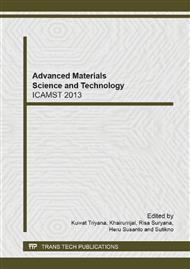p.626
p.633
p.638
p.642
p.646
p.650
p.656
p.660
p.664
Neutron Diffraction Measurements on Dissimilar Metal Weld of Cu-Al Obtained by Friction Stir Welding Method
Abstract:
Dissimilar metal weld (DMW) of Cu and Al alloy, namely DMW CuAl, was produced using Friction Stir Welding (FSW) technique. Characterization was performed at retreating and advancing side by neutron diffraction method. It is obtained that the weight percent composition of Cu and Al are dynamically change, depend on weld zone and welding direction. In SZ Cu element 55,18%, and it is majority component in the retreating side and it decreases gradually from the retreating side to the advancing side. The weight percent composition of Cu in the retreating side at HAZ and TMAZ are 99.25 %, and 61.25%, respectively, and in the advancing side are 0.35% and 38.75 %, respectively. Cu Bragg peaks of (111), (200) and (220) show that peak width ratio of BMZ / SZ is approximately 13%. This indicates a change in crystallite size that affects the behavior of plastic deformation in the welded material.
Info:
Periodical:
Pages:
646-649
Citation:
Online since:
February 2014
Authors:
Price:
Сopyright:
© 2014 Trans Tech Publications Ltd. All Rights Reserved
Share:
Citation:


